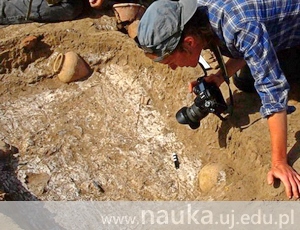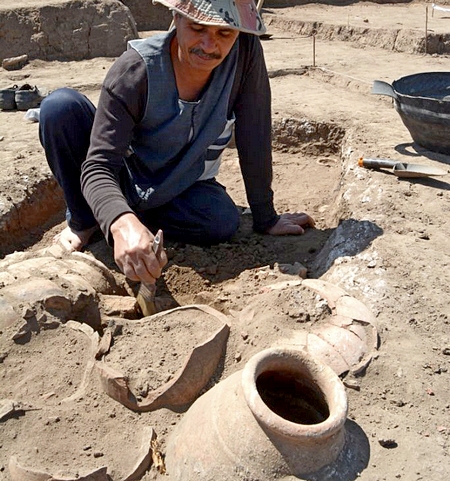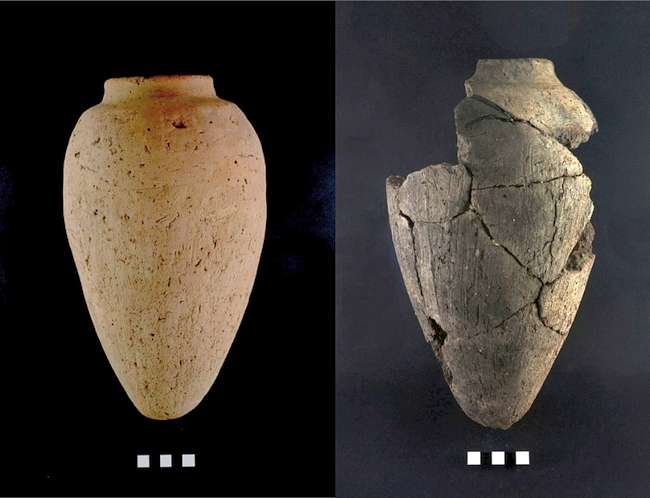
In March 2017, researchers from the JU Institute of Archaeology began another season of excavations in Egypt, at the Tell el-Murra site located in the eastern part of the Nile Delta.
The history of the area from 5,000–6,000 years ago is now well known. It’s been widely regarded that only the inhabitants of the Nile Valley played a major role in shaping the Egyptian civilisation. However, recent discoveries suggest that inhabitants of the river’s delta might have also contributed to the process of state formation. We know that the Nile Delta was densely populated in that time, and many historical population centres had their beginnings way before the Egyptian kingdom. The delta’s geographical location and fertile soil provided perfect conditions for developing settlements. Long distance trade, especially with the area of Levant (now Jordan, Israel, and Syria), was also an important factor.
The search for knowledge

Many of the issues related to the Nile Delta are still not very clear. For modern Egyptology, the most important task is to learn more about the interrelations of specific population centres and investigate the character of the changes that happened in various settlements over time.
The answers to those questions are sought by Kraków archaeologists led by Dr Mariusz Jucha (JU Institute of Archaeology). ‘The research at Tell el-Murra this year will be focused on a settlement from around 3,000 BCE. We’re uncovering buildings from the Early Dynastic Period as well as some others from the Old Kingdom, made out of dried brick’ said Grzegorz Bąk-Pryc, leader of the field research. Among numerous discovered remains, complexes with hearths and food storages are the predominant ones. This is proved by ceramic, flint and stone vessels found in abundance in the area. The everyday life of the Tell el-Murra settlement inhabitants can also be reconstructed by analysing animal bones and plant macroremains acquired from the buildings. ‘We’re still not sure about the role of the settlement with respect to other sites we’ve discovered in this part of the delta. It’s important to stress that despite similar discoveries being found in neighbouring sites, there are certain dissimilarities between them. They may be the result of different social status or different cultural traditions of people migrating from the south. We’re still trying to figure that out’, the Kraków archaeologist added.
An abandoned settlement
Tell el-Murra is a hillock surrounded by ploughlands interspersed by irrigation channels. The field research in this area began in 2008. Previous results allowed to estimate the site’s age at about 3,500–2,200 BCE. The oldest settlement was founded in the Predynastic period (about 3,500 BCE) by settlers belonging to Lower Egyptian culture developing in the northern parts of Egypt. It was before the arrival of the first representatives of the southern Nagada culture. As they expanded in the direction of the delta and mixed with the local population, the entire Egypt became culturally homogenous.

The Tell el-Murra settlement flourished shortly before the formation of the Egyptian kingdom. In the beginning of 3,000 BCE, the south-western part of the settlement became a graveyard. By around 2,200 BCE, the settlement had become completely abandoned. No research studies have provided any information on what happened later. We still don’t know the reason for abandoning the settlement at the end of the Old Kingdom. The archaeologists are particularly interested in the circumstances of the slow decline of other similar locations. Gathering more information on this subject would greatly benefit the analyses of ancient Egypt’s rise and development.
The archaeological research in Tell el-Murra is one of the projects realised in the eastern part of the Nile Delta by the students and staff of the JU Institute of Archaeology. These studies are conducted in collaboration with large administrative centres in the area, most notably Tell el-Farcha.
Original text: www.nauka.uj.edu.pl





